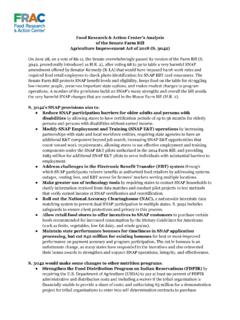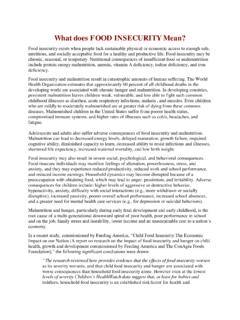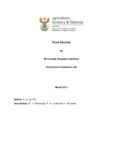Transcription of ResearchWIRE
1 FRAC ResearchWIRE n food Research & Action Center n 1 food insecurity , the Federal Nutrition Programs, and Health Maintaining good health, consuming a nutritious diet, managing an existing chronic disease, or a combination of these can be a particularly difficult challenge for those struggling with poverty or food insecurity . Limited finances and resources, competing priorities, and stress exacerbate the challenge. In addition, those impacted by poverty or food insecurity are likely experiencing additional resource-related hardships ( , housing instability, energy insecurity ) that, in turn, can contribute to poor nutrition, health, and disease management.
2 A new white paper from FRAC reviews the latest research on the harmful impacts of poverty, food insecurity , and poor nutrition on the health and well-being of children, adults, and older adults. Two other accompanying white papers describe the critical role of the Supplemental Nutrition Assistance Program (SNAP) and the federal Child Nutrition Programs in alleviating poverty, reducing food insecurity , and improving nutrition, health, and well-being. Key findings from, and links to, the three papers are provided Welcome to the food Research & Action Center s inaugural issue of ResearchWIRE . This newsletter focuses on the latest research, reports, and resources from government agencies, academic researchers, think tanks, and elsewhere at the intersection of food insecurity , poverty, the federal nutrition programs, and 2017IN THIS ISSUEn In Focus: food insecurity , the Federal Nutrition Programs, and Healthn Research Highlights: Supplemental Nutrition Assistance Program (SNAP) Child Nutrition Programs Health and Dietary Quality College Studentsn From Children s HealthWatch.
3 Moving From Hardship to Health food insecurity is a Health Issue In 2016, approximately million adults ( percent of all adults) and million children ( percent of all children) lived in food -insecure food insecurity even marginal food security (a less severe level of food insecurity not included in these numbers) is associated with some of the most common and costly health problems among adults and older adults, including fair or poor health status, diabetes, obesity (primarily among women), hypertension, and depression (including maternal depression). The consequences of food insecurity and, again, even marginal food security are especially detrimental to the health, development, and well-being of children.
4 Research shows a link for children between food insecurity and lower health status, low birth weight, birth defects, iron deficiency anemia, more frequent colds and stomachaches, asthma, developmental risk, mental health problems, and poor educational performance and academic outcomes all of which have health and economic consequences in the short and long ON NEXT PAGEFRAC ResearchWIRE n food Research & Action Center n 2 CONTINUED FROM PREVIOUS PAGE Because of limited financial resources, households that are food insecure also may use coping strategies to stretch budgets that are harmful for health, such as engaging in cost-related medication underuse or non-adherence, postponing or forgoing preventive or needed medical care, forgoing the foods needed for special medical diets ( , diabetic diets), or diluting or rationing infant formula.
5 food insecurity and coping strategies such as these can exacerbate existing disease and compromise health. Not surprisingly, research shows that household food insecurity is a strong predictor of higher health care utilization and increased health care costs. The direct and indirect health-related costs of hunger and food insecurity in the have been estimated to be $160 billion for 2014 the full white paper on food insecurity as a health issue as well as access citations for this section. SNAP and Public Health: The Role of the Supplemental Nutrition Assistance Program in Improving Health and Well-Being SNAP (formerly food stamps ) serves as the first line of the nation s public policy defense against hunger and undernutrition as well as an effective anti-poverty initiative.
6 This invaluable program has a critical role, not just in reducing food insecurity , but in improving the health of the nation, especially among the most vulnerable Americans. Improving access to SNAP and improving SNAP benefit levels would further SNAP s role in improving the public s health. Consider the following selection of studies:n SNAP participation was associated with lower health care spending among low-income adults in a national According to one estimate, annual healthcare expenditures averaged $1,409 lower in the case of SNAP participants versus non-participants, and even larger differences occurred among SNAP participants with hypertension or coronary heart ,5 n Access to SNAP in utero and in early childhood reduced the incidence of metabolic syndrome (obesity, hypertension, diabetes, heart disease, heart attack)
7 , reduced the risk of stunting, and, for women, increased reports of being in good health in adulthood, based on a study of people who grew up in disadvantaged families and were born between 1956 and n SNAP participation was associated with reduced hospitalization and, among those who were hospitalized, less costly hospital stays, in a study of Maryland older adults dually enrolled in Medicare and Medicaid. According to the study team s estimates, expanding SNAP access to nonparticipating dual eligible older adults in Maryland could have resulted in inpatient hospital cost savings of $19 million in 2012. 7 In addition, a companion study found an association between SNAP participation and reduced nursing home admissions and admission costs, with estimated cost savings of $34 million in 2012 if SNAP had been provided to eligible n In Massachusetts, inpatient Medicaid cost growth significantly declined after the temporary increase in SNAP benefits pursuant to the American Recovery and Reinvestment Act (ARRA)
8 Of 2009, especially among people with chronic The cost declines were driven by reduced hospital admissions and, to a lesser extent, reduced length of stay per the full white paper on SNAP s role in alleviating poverty and food insecurity and in improving dietary intake, weight outcomes, and ON NEXT PAGEFRAC ResearchWIRE n food Research & Action Center n 3 CONTINUED FROM PREVIOUS PAGEC hild Nutrition Programs and Public Health: The Role of the Federal Child Nutrition Programs in Improving Health and Well-BeingPoverty, food insecurity , and poor nutrition have detrimental impacts on the health and well-being of children in the short and long terms.
9 One critical strategy to address these impacts is connecting vulnerable children and their families to the federal Child Nutrition Programs, , the Special Supplemental Nutrition Program for Women, Infants, and Children (WIC); National School Lunch Program (NSLP); School Breakfast Program (SBP); Child and Adult Care food Program (CACFP); Summer food Service Program (SFSP); and Afterschool Nutrition Programs. Below are the health-related benefits of the Child Nutrition Programs:n Low-income students who eat both school breakfast and lunch have significantly better overall diet quality than low-income students who do not eat school School breakfast, including breakfast offered at no cost to all students in a school, has been linked with fewer visits to the school nurse, particularly in the morning,11 and positive impacts on mental health, including reductions in behavioral problems, anxiety, and ,13 n Free or reduced-price school lunches reduce rates of poor health by at least 29 percent.
10 Based on estimates using national Young children in subsidized child care whose meals are supplied by their child care provider and, therefore, highly likely to be participating in CACFP are less likely to be in fair or poor health, less likely to be hospitalized, and more likely to be at a healthy weight than similar children whose meals are supplied from n WIC enrollment and greater WIC food package utilization during pregnancy are associated with improved birth outcomes, including lower risk of preterm birth, low birth weight, and perinatal Read the full white paper on the important role of the Child Nutrition Programs in improving food and economic security, dietary intake, weight outcomes, health, and Protecting and improving the public s health is critically important for the nation.















